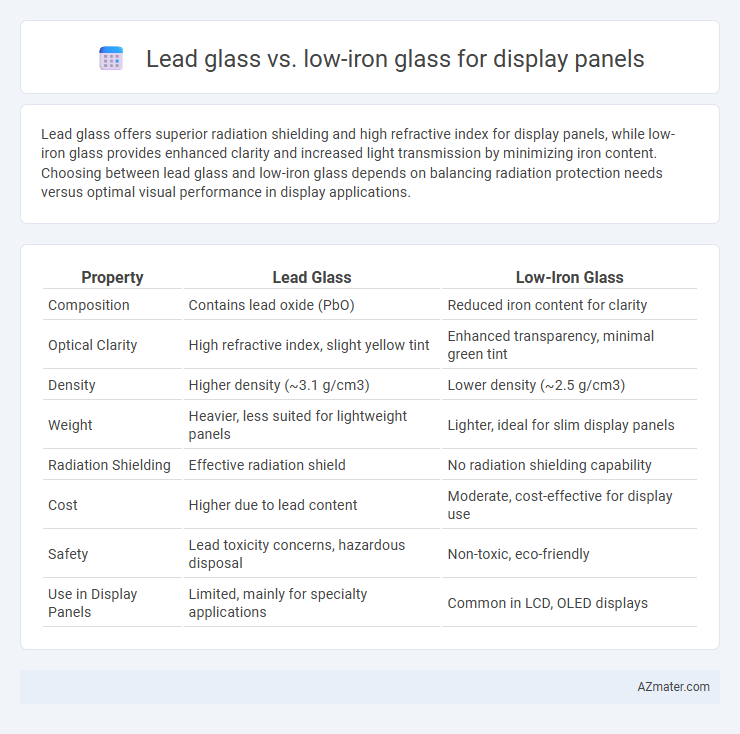Lead glass offers superior radiation shielding and high refractive index for display panels, while low-iron glass provides enhanced clarity and increased light transmission by minimizing iron content. Choosing between lead glass and low-iron glass depends on balancing radiation protection needs versus optimal visual performance in display applications.
Table of Comparison
| Property | Lead Glass | Low-Iron Glass |
|---|---|---|
| Composition | Contains lead oxide (PbO) | Reduced iron content for clarity |
| Optical Clarity | High refractive index, slight yellow tint | Enhanced transparency, minimal green tint |
| Density | Higher density (~3.1 g/cm3) | Lower density (~2.5 g/cm3) |
| Weight | Heavier, less suited for lightweight panels | Lighter, ideal for slim display panels |
| Radiation Shielding | Effective radiation shield | No radiation shielding capability |
| Cost | Higher due to lead content | Moderate, cost-effective for display use |
| Safety | Lead toxicity concerns, hazardous disposal | Non-toxic, eco-friendly |
| Use in Display Panels | Limited, mainly for specialty applications | Common in LCD, OLED displays |
Introduction: Lead Glass vs Low-Iron Glass in Display Panels
Lead glass offers superior radiation shielding and enhanced durability, making it suitable for specialized display panels that require protection from harmful emissions. Low-iron glass provides higher optical clarity and better light transmission, crucial for vibrant and accurate display visuals. Choosing between lead glass and low-iron glass depends on balancing radiation protection needs against color fidelity and brightness in display panel applications.
Composition and Chemical Properties
Lead glass contains lead oxide (PbO) typically between 18-40%, which enhances its refractive index and density, resulting in improved light dispersion and brilliance for display panels. Low-iron glass has significantly reduced iron oxide (Fe2O3) content, usually less than 0.01%, minimizing greenish tint and maximizing light transmission and color accuracy. The chemical stability of lead glass is lower due to lead leaching potential, whereas low-iron glass offers higher chemical durability and resistance to weathering in display applications.
Optical Clarity and Light Transmission
Lead glass exhibits higher refractive index and exceptional dispersion properties, enhancing contrast and color fidelity in display panels. Low-iron glass offers superior optical clarity with minimal greenish tint, providing increased light transmission of up to 91% compared to standard glass types. Both materials impact display quality, but low-iron glass is preferred for maximizing brightness and true color representation in high-end screens.
Color Accuracy and Visual Performance
Lead glass offers exceptional color accuracy with high refractive index properties, enhancing contrast and color depth in display panels. Low-iron glass minimizes greenish tint and improves light transmission, resulting in clearer visuals and truer color representation. Both materials boost visual performance, but lead glass excels in color richness while low-iron glass provides superior clarity and brightness.
Strength and Durability Factors
Lead glass exhibits higher density and improved radiation shielding but tends to be more brittle compared to low-iron glass, affecting its structural strength in display panels. Low-iron glass offers superior clarity and enhanced mechanical strength due to its reduced iron content, which minimizes green tint and improves durability under physical stress. In terms of impact resistance and longevity, low-iron glass is generally preferred for display panels requiring robust performance and prolonged use.
Weight and Thickness Considerations
Lead glass, known for its higher density due to lead oxide content, is significantly heavier than low-iron glass, impacting the overall weight of display panels and making it less suitable for lightweight applications. Low-iron glass offers reduced thickness options while maintaining clarity, enabling slimmer, lighter display panels with enhanced light transmission and minimal green tint. Choosing low-iron glass improves portability and ergonomic design in displays where weight and thinness are critical factors.
Safety and Environmental Impact
Lead glass used in display panels poses significant environmental and health risks due to its high lead content, which is toxic and challenging to recycle safely. Low-iron glass offers a safer alternative with minimal toxic elements, reducing environmental contamination and facilitating eco-friendly disposal. Choosing low-iron glass enhances safety for manufacturers and consumers while supporting sustainable production practices.
Cost Comparison and Availability
Lead glass typically incurs higher production costs due to the inclusion of lead oxide, which enhances density and refractive properties but demands specialized handling and manufacturing processes. Low-iron glass, widely produced for display panels, offers cost advantages by reducing iron content to improve clarity without significantly increasing material expenses, making it more readily available in large quantities. Considering budget constraints and supply chain stability, low-iron glass generally presents a more economical and accessible option compared to lead glass for display panel applications.
Best Applications for Display Panels
Lead glass enhances display panels with superior radiation shielding and high refractive index, making it ideal for medical imaging and high-precision optical devices. Low-iron glass offers exceptional clarity and color accuracy by minimizing greenish tint, which benefits premium displays like smartphones, tablets, and large-format monitors. Selecting low-iron glass ensures vivid color reproduction in environments demanding high transparency and light transmission.
Choosing the Right Glass for Your Display Needs
Lead glass offers superior radiation shielding and higher refractive index, making it ideal for specialized display panels requiring enhanced image clarity and protection. Low-iron glass provides exceptional transparency and color accuracy by minimizing iron content, perfect for high-definition displays where true color representation and brightness are critical. Selecting between lead glass and low-iron glass depends on whether display priority lies in radiation protection or achieving maximum optical purity and color fidelity.

Infographic: Lead glass vs Low-iron glass for Display panel
 azmater.com
azmater.com